According to our guide Bold, all Mongolian music is about just three things: love, mothers, and horses. Those are the most important aspects of Mongolian life, he claimed, and not necessarily in that order. Tog Toh, our driver, often played music videos on his car’s LCD screen as we rumbled through the desert. Rihanna, Shakira, and Selena Gomez alternated with Mongolian videos that – sure enough – always featured slow-motion scenes of horses running through open fields.
Oddly, though, Mongolians don’t usually name their horses, or any of their other animals.* Maybe there are just too many of them. Livestock outnumber people 20 to one. Three million Mongolians have more than 60 million of what they call the “five muzzles” – horses, cows, goats, sheep, and camels, the core grazing animals on which nomads build their life.
“How about chickens?” I asked Bold. “Do many people raise chickens here?”
“If someone farmed chickens, people would think he was gay.”
Marie and I exchanged puzzled glances – had we heard him right? Before we could follow up, Bold realized he’d said something inappropriate and quickly changed topics. We let it drop, interpreting Bold’s comment as his way of communicating a reality of the macho Mongolian culture: chicken farming is considered effeminate. That would help explain why we never once saw a chicken.
In contrast we’d seen countless horses, cows, goats, and sheep, and as we dropped deeper into the Gobi we began passing large herds of Bactrian camels. I asked Tog Toh to stop so we could get out for a closer look.



We ate lunch in Dalanzadgad – the largest city in the southern Gobi (which is a little like saying the tallest mountain in Kansas) – and continued to a ger camp on the outskirts of town. The weather had turned windy and surprisingly cold, prompting a change of plans. We decided to postpone our visit to the Yolyn Am ice canyon until the next morning, hoping for better weather, and make up the time later. Weather in the Gobi is unpredictable in May. One day it could snow and the next day could be sunny and warm.
Neither Marie nor I were fully healthy – she was getting over a cold and I’d caught one just before arriving in Mongolia – so we appreciated the rest. It also gave Tog Toh, who lives in Dalanzadgad, a chance to spend the afternoon and night with his wife and newborn baby.
“If you need me I’ll be in my ger reciting mantras,” Bold informed us.
Marie and I spent part of the afternoon trying to figure out what we were sleeping on. In almost every ger camp the pillows were filled with something that felt like pebbles, only lighter. “Seeds?” guessed Marie. “Little bits of plastic?”
Google solved the mystery. The pillows were stuffed with buckwheat hulls. “They say it keeps them fresh,” Bold said later.
The weather improved slightly the next morning and we drove into Gurvan Saikhan (sometimes called Gobi Gurvansaikhan) National Park, the largest national park in Mongolia, where we spent the next several days. Our first stop was Yolyn Am – one of the Gobi’s “Big Three” attractions (along with Khongoryn Els and the Flaming Cliffs). The steep walls in the Yolyn Am canyon block the sun so effectively that ice persists along the riverbed well into the summer.

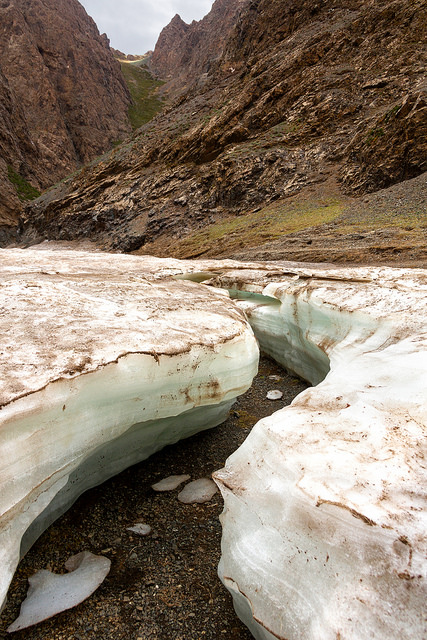
Exploring the ice was all well and good, but I was more interested in the wildlife. Countless pika burrowed in the ground on the valley floor, and from a distance we spotted bighorn mountain sheep, gazelles, and a couple of sleek, wary foxes.




Our next stop was Khavtsgait, a rocky hillside covered with petroglyphs. Some of the more rudimentary carvings are thought to date back to 3000 BC.


Cold rain and even a few snowflakes fell as we drove on to Khongoryn Els, putting a mild damper on my excitement. People often think the Gobi is covered in sand, but the region is only a semi-desert and dunes are rare. Khongoryn Els, also called the Singing Sands, is one of the most extensive dune fields in the country. I love photographing sand dunes and couldn’t wait to see Khongoryn Els. The bad weather prevented us from driving out to the dunes that evening, which was disappointing, but we planned to stay in the area for two nights, long enough for our luck to improve.

The temperature continued to drop and someone came to light our stove. Filled with cow dung and coal, the stove initially turned our ger into an unbearable sauna but then burned out after we fell asleep, leaving us so cold that even under our blankets I had to put on my jacket. The same pattern repeated itself at the rest of our ger camps. “Maybe we should take turns getting up in the middle of the night to feed the stove?” I suggested to Marie.
“Would you really trust me to take my turn?” We both started laughing.



Sunlight greeted us the next morning and after breakfast we headed straight for the dunes. Bold and Tog Toh left me and Marie to explore on our own while they went to arrange camels for us to ride later. We climbed to the top of the highest dune in our area.







The views were amazing. The long line of the Singing Sands stretched to the far horizon.





Our window of sun closed quickly. A new wave of clouds rolled in, blanketing the sky for the rest of our time at Khongoryn Els. I wished we’d had better weather, but I was grateful the sun cooperated for at least an hour or two. It would have been a real gut punch to make it all the way to the Gobi only to leave without any shots of dunes in good light.
A short drive took us to a small homestead at the base of the dunes where a nomad family kept camels and goats. The adults prepared camels for us to ride while the children introduced us to the goats. One little goat eager to nurse latched on to Marie’s finger so enthusiastically that it broke the skin. “Nobody warned us about vampiric goats,” Marie complained with a laugh as she doused her bloody finger in Purell.
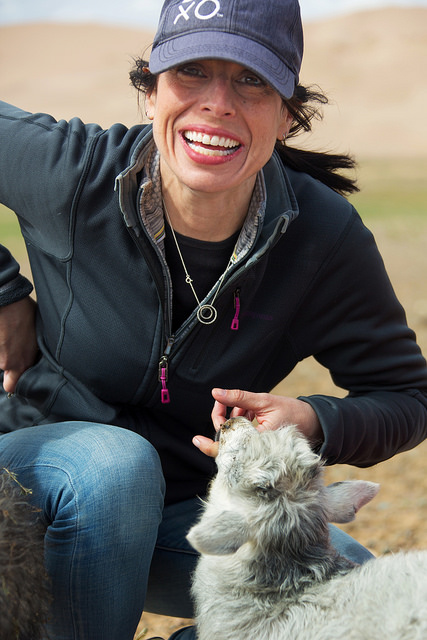


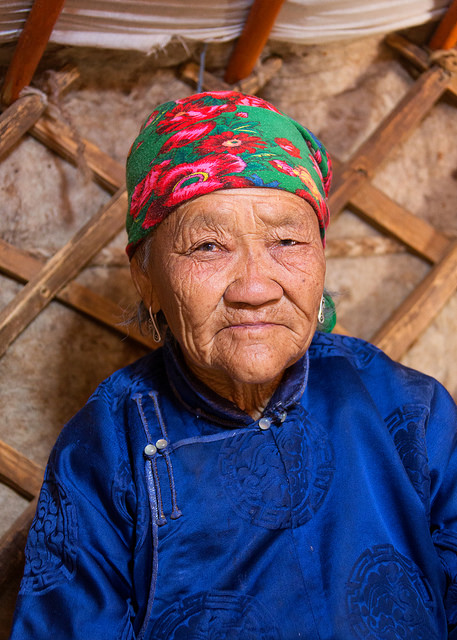
Marie and I were savvy camel veterans, having ridden one-humped camels in India, but this was our first time on a two-humped Bactrian camel. It was fun to be so close to such unique animals, but what we did wasn’t really riding – we were just led around by one of the family’s kids. After a half hour we said we’d had enough.


We drove away from the dunes the next morning, the weather still cold and cloudy. We’d been trying to get Bold to understand that we’d much rather interact with locals than go to museums, which prompted a generous offer from Tog Toh to have lunch at the ger of his sister-in-law, Badma. As we waited for Badma to show up we were invited into her neighbor’s ger for milk tea and bread.



Badma soon arrived with the ingredients for lunch and she and Tog Toh spent an hour preparing from scratch the same kind of dumplings we’d enjoyed so much earlier in the trip. It was an impressive spread – mutton dumplings in goat milk tea, camel jerky, yogurt, sheep tail, and fried rice. Tog Toh also gave us each a white bowl filled with a clear liquid called arkhi, a home-made alcohol fermented from goat’s milk. Easily the best meal we had in Mongolia.

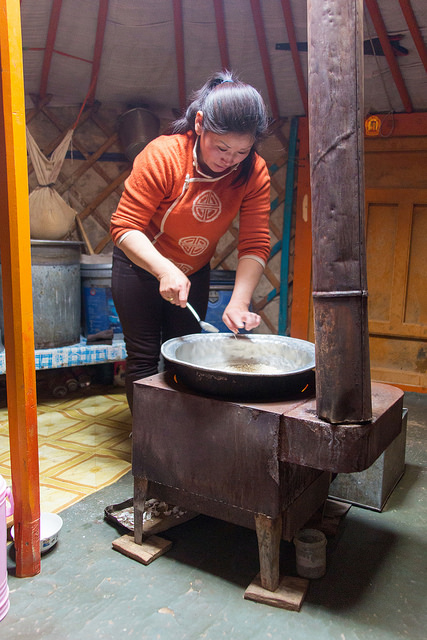



After lunch Tog Toh introduced us to the camels he kept at Badma’s place. Badma’s family watched over them along with their own 50 camels and hundreds of sheep and goats.
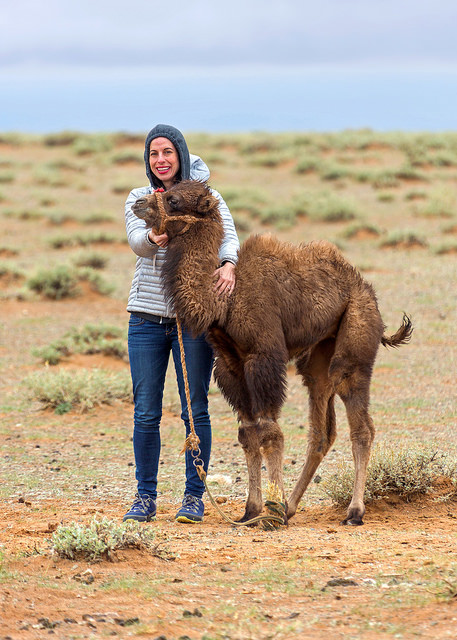


Our destination for the night was a ger camp near Bayanzag, also called The Flaming Cliffs, where an American named Roy Chapman Andrews made a series of significant dinosaur fossil discoveries in the 1920s, including the first (or maybe second) time dinosaur eggs were ever found.
“The road there is very good,” Bold assured us. Cut to Marie and I thrashing from side-to-side as Tog Toh’s Land Cruiser bounced violently over a washboard of ruts and bumps.

At the ger camp that afternoon I went out to look around and ended up taking a long walk towards Bayanzag. An hour later it felt like I’d barely made any progress – the ger camp was still in plain sight and I didn’t seem to be much closer to the Flaming Cliffs. It helped me appreciate the critical importance of horses on the steppe. Before engines, how else could you get anywhere in all that space?


Speaking of engines, we saw far more nomads herding their animals on a motorcycle than on horseback. A few times we saw nomads herding cows with their car. And only once in the Gobi did we see a woman on horseback.

The next morning we explored the Flaming Cliffs. The sun made a welcome appearance as we wandered around the base of the eroded hills.






After a while Bold called us over. “Tog Toh found some dinosaur bones.”
Whoa! Tog Toh, carefully removing a layer of dirt with a toothbrush, had uncovered two small bones. I couldn’t help but think of a childhood vacation at a dude ranch in Colorado, where the workers surreptitiously scattered nuggets of fool’s gold in a creek for us to find. But I had to admit the bones looked like the real deal.
Bold said a simple test could help differentiate between ancient fossils and the remains of modern animals: lick your finger and touch the bone. If it sticks, it may be ancient. If it doesn’t, it’s probably not.
Marie licked her finger and touched one of the bones, which clung to her skin so firmly that a chunk broke off when she pulled her finger away. Tog Toh was not amused. He quickly covered up the bones again to protect his discovery.

From Bayanzag we drove north. We still had a few more places left to visit before circling back to Ulaanbaatar, but our time in the Gobi was almost over.
* This applies to dogs as well, even though many Mongolians grow extremely fond of their canine companions. According to Bold, particularly beloved dogs are buried with their tails cut off and a bit of fat placed in their mouth. Cutting off their tails signifies the wish that they will progress to being reborn as a (tail-less) human in their next life, and the fat is intended to increase the chances they’ll be reborn wealthy.
(If you’re interested in visiting Mongolia and want some help planning your trip, I can highly recommend Daka Nyamdorj, who runs Happy Mongolia tours. Let me know if you’d like me to connect you.)

Fantastic post! I particularly like “Early Light on Clouds Over the Steppe”. (And the picture of you on the camel, of course.)
>
LikeLike